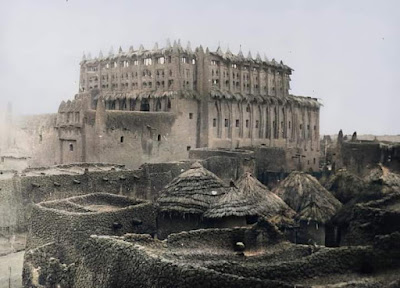This castle in Korhogo, Ivory Coast was built in the 13th-century ce during the Medieval Mali Empire expansion. Mali expansion into today Ivory Coast was central to their wealth, as the Ivory Coast (and Gold Coast) was a great source of the gold that made Mali rich.
What makes this a castle, and not just palace, are the defensive fortifications built into the royal structure. As you can see, there are several stories to the castle with many windows, but at the very top there are a series of archers' openings, from which the royal guard would shoot arrows at invaders and then hide behind a pillar when shot at. This is the typical feature of a castle, dating all the way back to Buhen, Nubia, the world's oldest castle.
Another distinguishing feature of castles over palaces are the presence of fortified thick walls. If you look at the photo, you can see that the castle is surrounded by a thick wall (between the castle proper and the thatched roof huts); so thick it looks like a building on its own. But that is in fact a wall surrounding the castle and its several structures.
The castle also featured barracks and equestrian stables for the knights, the central military class in the Mali Empire. It was their invincible equestrian knights that gave Mali the power to forge an empire that covered nearly all of West Africa and the Western Sahara up to the doors of Marrakesh, Morocco.
The first large supply of captives to leave West Africa for the Americas came when the SonghaiMali Empire collapsed in 1591 and its citizens were captured by Arab-Moroccans and sold to Europoids.
Korhogo Castle was first bombed by the French in the late 19th century as part of the joint European gang rape of Africa. Many of its larger structures were damaged.
The final remains of the castle (as seen in this photo) were destroyed in 1939 by the French as part of their systematic campaign to erase traces of intelligent history in Francophone Africa. #Africa


No comments:
Post a Comment